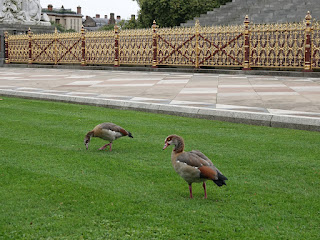Four Red-Crested Pochards were preening on the edge of the Serpentine. Three of them were drakes in eclipse, with female-type plumage -- they will return to their bright breeding plumage later in the year. Even in eclipse they keep their red eyes and bill. The second one from the front looks like a female, with a pink-tipped brown bill and brown eyes. But when you look more closely at it -- click on the following still picture to enlarge it -- it has patches of red on its bill and its eyes are a dull red. I am wondering whether this duck is transitioning to male, which is something that sometimes happens to female ducks. See this page for more information on the strange subject.
Drakes go into eclipse to moult their flight feathers, since dull plumage gives them some protection while they are flightless. This female Mallard, moulting at the same time, has only just started refurnishing her wings.
A pair of Egyptian Geese turned up in an odd place, at the edge of the Albert Memorial. Perhaps they were attracted by the tasty well kept grass on the surrounding lawn.
In the background you can see the magnificent gilded railings designed by the architect of the memorial George Gilbert Scott, and made by the master of Victorian ironwork Francis Skidmore.
A Cormorant fishing by the Serpentine island jumped on to a post and succeeded in making a neat landing. Their webbed feet aren't very grippy, and sometimes they lose their footing and fall into the water. I hope to be able to film this some day.
The three Great Crested Grebe chicks on the Serpentine have become very adventurous when not chasing their parents for food, and this one was alone at the east end of the lake. Their ability to crash dive in an instant keeps them reasonably safe from Herring Gulls.
A Moorhen climbed around in a bush beside the Vista. I haven't seen the single Moorhen chick that was around here for some time, but this is a hard place to see anything.
The three Grey Heron chicks were in their nest. The biggest of them, on the left here, is getting restless and will start climbing around soon.
The teenager from the previous nest was on a post.
The widowed male Peregrine was on the tower, but again standing well back from the edge so that you could only see him from a distance. He is a distinctively dark bird with hardly any white on the side of his face.
The female Little Owl at the Round Pond was in yet another place in the horse chestnut tree, hard to photograph in the shade and on a dim grey day.
A Jay waited near Mount Gate for a peanut, with its crest up and its silly Groucho Marx moustache showing well in front view.
Eleven Robins were singing in the Flower Walk. I've never heard so many here.
The inevitable Chaffinch was also waiting on the railings.
A party of Long-Tailed Tits visited a dead hawthorn tree near the bridge ...
... accompanied by some Blue Tits one of which was digging a small larva out of the lichen.
In the next tree, which was alive, a Wood Pigeon was eating the fruit.
You can see that live hawthorns as well as dead ones get encrusted with lichen, and evidently it's the insects in this that make hawthorns a favourite with tits and other small insect-eating birds.















I knew frogs were able to change sex when the environment was especially harsh, but I would never in a million years have imagined hat some ducks could do so as well. Colour me speechless.
ReplyDeleteTinúviel
They must retain their original sex chromosomes (ZW for females, ZZ for true males) so it's not quite a 100% change.
DeleteInteresting. But all female birds have only one ovary - so why is it only ducks that can change?
ReplyDeleteIf I knew the answer to that, nations would bow before me.
Delete